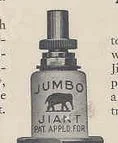Transportation
Franklyn P. Salimbene’s account of the last streetcar ride from Arborway on December 28, 1985. Originally, described as a “temporary suspension” this service has never been restored, although efforts to extend the end of the E line from Heath Street to Hyde Square continue.
The Lenox Motor Car Company manufactured automobiles from 1917 to 1920. Their factory in Jamaica Plain was located at 3368 Washington St. The company was the successor to the Martell Motor Car Company in Jamaica Plain.
In a staged photograph that was taken on South St. in Jamaica Plain the new advanced safety brakes installed on the streetcars are shown saving the life of wee lad chasing his hoop into the street.
Ad for the Jumbo Jiant spark plug in the February 10, 1915 issue of The Automobile magazine. The Jiant was manufactured by Gibson-Hollister Mfg at 3380 Washington St. in Jamaica Plain.
Columbus Avenue is one of Jamaica Plain’s best-known border streets. It was once called Lowell Street from its border on the Lowell estate, that nursery of a generation of faded Americans, and later Pynchon Street after the founder of Roxbury and Springfield.
Public transport has been a feature of the Jamaica Plain landscape for nearly 150 years. One of the early forms was the omnibus, an oversized horse carriage that plied the busy sections of road between Boston and outlying villages like Jamaica Plain.
Our area is infamous for the bridge not built in the Stony Brook valley. This is the overpass that carries the Jamaicaway, turning into Riverway, over Rte. 9 at the Boston/Brookline border.
The recent rebuilding of Dudley Street Station in the heart of Roxbury is a glorious blend of the past with present needs. Unlike any other (but one) of the old Orange Line stations, which disappeared when the line was moved west to be with the railroad tracks, Dudley Street Station, due to its location as a terminus and distribution point for buses, had to be remade.
Just as Hadrian's Wall separates Britain from the rest of the British Isles, so the railroad embankment marked a demographic and economic shift in our area. In the 1980s the depressed Orange Line and the city's only 20th century park alongside nicely replaced it.
This article is a slightly edited transcript of a presentation and discussion that took place September 28, 2014 at Doyle’s Café in Jamaica Plain. The panel was moderated by Jim Vrabel, author of 'A People's History of the New Boston' and the panelists included: John Bassett, Ron Hafer, and Tom Corrigan who were activists trying to stop the Southwest Expressway highway project going through Jamaica Plain.
The opening of the elevated extension to Forest Hills, which had been delayed, finally happened on Monday, November 22, 1909, when the public had the opportunity to see the great terminal station, and patrons from Forest Hills and points south had the chance to enjoy quicker transit to the city.
March 14, 1887 dawned gray and cold in Dedham, Massachusetts. It was a snappy Monday morning with the temperature at about 34 degrees. Shortly after 6:00 a.m., Boston & Providence Railroad engineer Walter White and his fireman Alfred Billings steamed their engine. The Bussey Bridge, toward which 200 souls in nine fragile coaches were heading, was by any standards, a peculiar structure.
On April 27, 1887 the report of the Railroad Commissioners regarding the Bussey Bridge train disaster on the Boston & Providence Railroad was presented to the United States Senate.
By the accident yesterday [March 14, 1887] on the Boston & Providence Railroad thirty-eight souls were buried into eternity and some forty persons were more or less injured. It was by all odds the most serious of any accident of a like nature that has happened in this State for many years.
The following explanation, prepared by a gentleman who has made a special study of the cause of the disaster at Bussey Bridge, will make clearer the statement written for the Engineering News and published in the Globe Thursday morning. The statement in the Engineering News refers to the defective character of two hangers which were found to have been seriously rusted along the welds at the lower ends.















